Indianapolis by Lynn Vincent

Author:Lynn Vincent [Vincent, Lynn & Vladic, Sara & Lloyd, John Bedford]
Language: eng
Format: epub
Publisher: Simon & Schuster
Published: 0101-01-01T00:00:00+00:00
4
AUGUST 15, 1945
ON WEDNESDAY, AUGUST 15, headlines—bold, all caps, and glorious—unfurled in newspapers across the nation:
New York Times:
JAPAN SURRENDERS, END OF WAR!
Orlando Morning Sentinel:
PEACE: JAPS QUIT
Cincinnati Enquirer:
WAR ENDS AS JAPAN QUITS. TODAY, THURSDAY ARE LEGAL HOLIDAYS
Western radio broadcasters also heralded the surrender news, and that is where, on August 15, kamikaze commander Vice Admiral Matome Ugaki learned for the first time that Great Japan now suffered before the world in humiliating defeat. The emperor himself addressed the nation via radio at noon. Ugaki was the commander who had sent the kamikaze planes—including the one that crashed Indy—against the U.S. fleet at Okinawa. Now, due to a poor signal, he could not understand Hirohito’s broadcast very well, but he could guess most of its sickening detail. As one of the officers His Majesty had entrusted with a nation-saving mission, Ugaki’s heart filled with shame.
Six months earlier, Ugaki had written in his journal that he would one day follow the example of the young kamikaze. Now that time had come. He had not personally received a cease-fire order, so he told his men to prepare Suisei planes at Oita airfield immediately.
At four in the afternoon, his men were to meet him there to drink the farewell cup. Ugaki sat down and made a final entry in his journal. He hoped that “all the Japanese people will overcome all hardships expected to come in the future, display the traditional spirit of this nation more than ever, do their best to rehabilitate this country, and finally revenge this defeat in the future. I myself have made up my mind to serve this country even after death takes my body from this earth.”
With that, Ugaki ended his war diary and commended it to a friend for safekeeping with instructions that it never fall into enemy hands. Then he headed for Oita airfield by car and found there eleven Suisei dive-bombers, engines already turning. On the tarmac, twenty-two aircrew stood ramrod straight, heads wrapped in white bands, each of their foreheads ablaze with a flat red disc, the emblem of the rising sun.
Looking them over, Ugaki softened. He gave an order to reduce to five the number of planes that would accompany him. But Lieutenant Tatsuo Nakatsuru would have none of it.
“We can’t stand by and see only five planes dispatched,” Nakatsuru told the assembly. “My unit is going to accompany him with full strength!”
Ugaki climbed up on a stand in front of the aircrew. Already, he had stripped his uniform of all insignia, including his rank. “Will all of you go with me?” he said.
The flying men raised their right hands skyward and cried as one: “Yes, sir!”
Minutes later, the crews boarded their bombers. As his plane taxied, Ugaki waved farewell to his staff, who stood on the tarmac, eyes brimming with tears. Ugaki was headed for Okinawa, where so many of his countrymen had lost their lives. He would ram the arrogant American ships and display the real spirit of the Japanese warrior.
Once airborne, the attack group arrowed south and disappeared.
Download
This site does not store any files on its server. We only index and link to content provided by other sites. Please contact the content providers to delete copyright contents if any and email us, we'll remove relevant links or contents immediately.
| Civilization & Culture | Expeditions & Discoveries |
| Jewish | Maritime History & Piracy |
| Religious | Slavery & Emancipation |
| Women in History |
Cecilia; Or, Memoirs of an Heiress — Volume 1 by Fanny Burney(31333)
Cecilia; Or, Memoirs of an Heiress — Volume 3 by Fanny Burney(30934)
Cecilia; Or, Memoirs of an Heiress — Volume 2 by Fanny Burney(30889)
The Secret History by Donna Tartt(16627)
Sapiens: A Brief History of Humankind by Yuval Noah Harari(13054)
Leonardo da Vinci by Walter Isaacson(11903)
The Radium Girls by Kate Moore(10908)
Sapiens by Yuval Noah Harari(4537)
The Wind in My Hair by Masih Alinejad(4424)
How Democracies Die by Steven Levitsky & Daniel Ziblatt(4399)
Homo Deus: A Brief History of Tomorrow by Yuval Noah Harari(4280)
Endurance: Shackleton's Incredible Voyage by Alfred Lansing(3845)
The Silk Roads by Peter Frankopan(3762)
Man's Search for Meaning by Viktor Frankl(3634)
Millionaire: The Philanderer, Gambler, and Duelist Who Invented Modern Finance by Janet Gleeson(3569)
The Rape of Nanking by Iris Chang(3516)
Hitler in Los Angeles by Steven J. Ross(3437)
The Motorcycle Diaries by Ernesto Che Guevara(3333)
Joan of Arc by Mary Gordon(3259)
